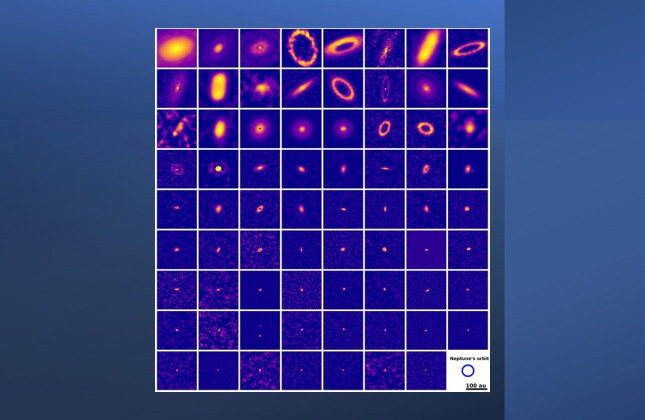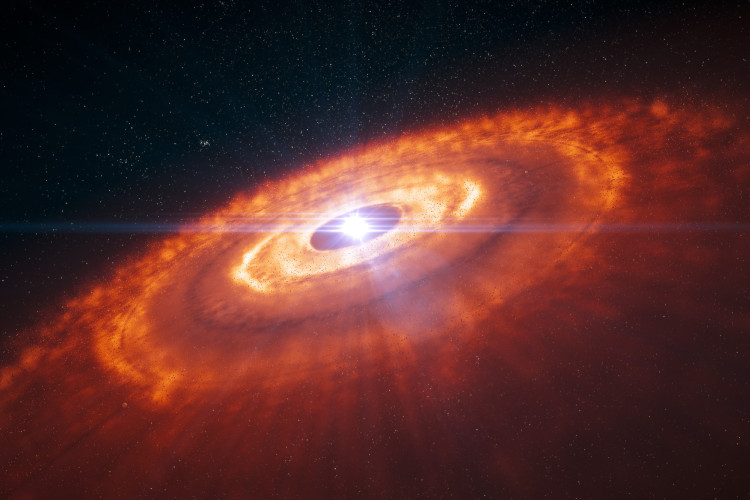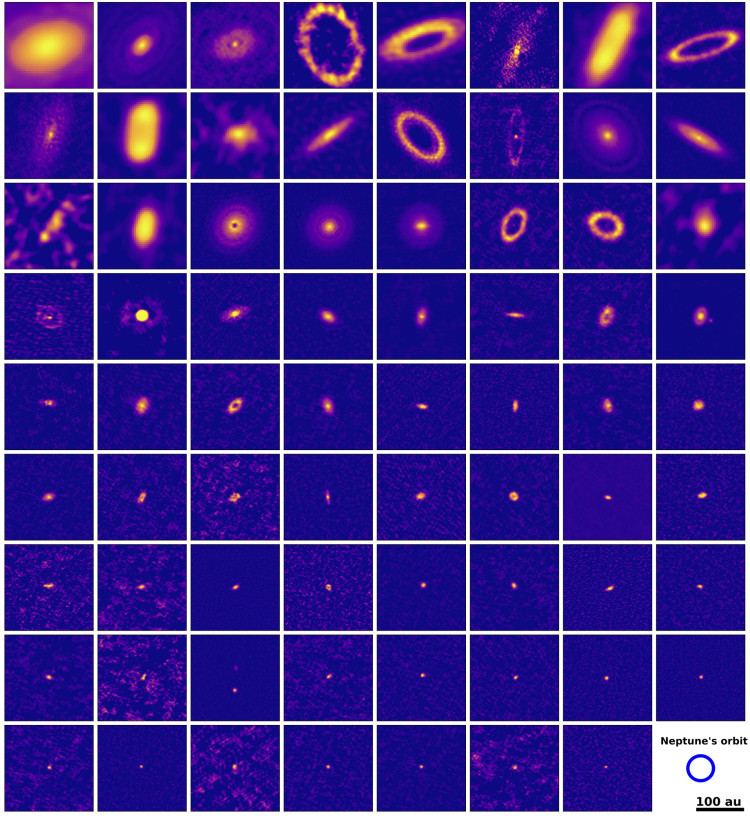31.03.2025
Many protoplanetary discs in which new planets are formed are much smaller than thought. Using the Atacama Large Millimeter/submillimeter Array (ALMA) scientists of the Leiden Observatory (the Netherlands) looked at 73 protoplanetary discs in the Lupus region. They found that many young stars host modest discs of gas and dust, some as small as 1.2 astronomical units. The research establishes an important link between observed protoplanetary discs and exoplanets.

73 protoplanetary discs in the Lupus star forming region. (c) Guerra-Alvarado et al.
In the past decade astronomers have imaged hundreds of protoplanetary discs around young stars using powerful radio telescopes on Earth, like ALMA. When compared to the size of our own Solar System, many of these discs extend far beyond the orbit of Neptune, our outermost planet. Furthermore, most of the discs show gaps where giant planets are thought to be formed. Research of PhD candidate Osmar M. Guerra-Alvarado, postdoc Mariana B. Sanchez and assistant professor Nienke van der Marel of the Leiden Observatory now shows that these discs might not be typical.
Using ALMA, the researchers imaged all known protoplanetary discs around young stars in Lupus, a star forming region located about 400 light years from Earth in the southern constellation Lupus. The survey reveals that two-thirds of the 73 discs are small, with an average radius of six astronomical units, this is about the orbit of Jupiter. The smallest disc found was only 0.6 astronomical units in radius, smaller than the orbit of Earth.
“These results completely change our view of what a ‘typical’ protoplanetary disc looks like”, Guerra-Alvarado says. “Only the brightest discs which are the easiest to observe show large-scale gaps, whereas compact discs without such substructures are actually much more common.”
Read more below the image.
Impression of a young star surrounded by a protoplanetary disc in which planets can form. (c) ESO/L. Calçada
Optimal conditions for super-Earths
The small discs were primarily found around low-mass stars, with a mass between 10 and 50 percent of the mass of our Sun. This is the most common type of star found in the universe. “The observations also show that these compact discs could have optimal conditions for the formation of so-called super-Earths, as most of the dust is close to the star, where super-Earths are typically found”, Sanchez says. She is a postdoc at Leiden Observatory and a contributor to this research. Super-Earths are rocky planets like Earth but with masses up to ten times that of our planet. This could also explain why super-Earths are often found around low-mass stars.
Furthermore, the research suggests that our Solar System was formed from a large protoplanetary disc that produced large gas planets like Jupiter and Saturn, but no super-Earth. Super-Earths are thought to be the most common planet types in the universe.
Text continues below video.
Artist’s rendering of planet-forming disc. (c) ESO/L. Calçada [several formats]
The missing link
The research establishes a ‘missing link’ between observations of protoplanetary discs and observations of exoplanets. “The discovery that the majority of the small discs do not show gaps, implies that the majority of stars do not host giant planets”, Van der Marel says. “This is consistent with what we see in exoplanet populations around full-grown stars. These observations link the disc population directly to the exoplanet population.”
Previous high-resolution observations of ALMA mainly focused on bright discs which are often much larger. For the smaller discs only the brightness was measured and not the size. High-resolution observations can be more complicated to take, and it was not clear if ALMA would be able to image the relatively faint discs.
For their research the scientists used ALMA observations, taken in 2023 and 2024, with the highest possible resolution of 0.030 arcsecond. They also used archival data to create a complete high resolution disc survey of an entire star forming region for the first time. Van der Marel: “The research shows that we’ve been wrong for a long time about how a typical disc looks like. Clearly, we’ve been biased towards the brightest and largest discs. Now we finally have a full overview of discs of all sizes.”
About ALMA
ALMA is a radio telescope that consists of 66 antennas spread over distances of up to 16 kilometres on the Chajnantor Plateau in the Chilean Andes. The project is a collaboration of Europe, the United States, Canada, Japan, Taiwan, Korea and Chile. Three types of receivers for the telescopes were built in the Netherlands: Band 5, Band 9 and Band 2. The sharpness of ALMA's image is up to 10 times that of the Hubble Space Telescope.
Scientific paper
A high-resolution survey of protoplanetary discs in Lupus and the nature of compact discs. By: Osmar M. Guerra-Alvarado, Nienke van der Marel, Jonathan P. Williams, Paola Pinilla, Gijs D. Mulders, Michiel Lambrechts, Mariana Sanchez. Accepted for publication in Astronomy & Astrophyiscs. [preprint]
 Images of 73 protoplanetary discs in the Lupus star forming region (two of the images contain binary stars). Only a fraction of the discs extend beyond the orbit of Neptune, when compared to our own Solar System. Most of the observed discs are small and show no structures like gaps and rings. (c) Guerra-Alvarado et al. (c) Guerra-Alvarado et al.
Images of 73 protoplanetary discs in the Lupus star forming region (two of the images contain binary stars). Only a fraction of the discs extend beyond the orbit of Neptune, when compared to our own Solar System. Most of the observed discs are small and show no structures like gaps and rings. (c) Guerra-Alvarado et al. (c) Guerra-Alvarado et al.
Quelle: Astronomie.nl
